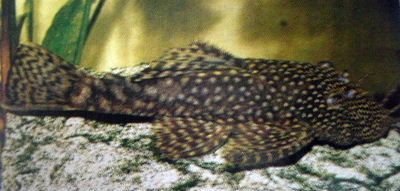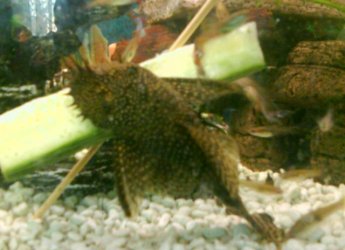Common Name/s: Bristlenose Catfish
Scientific Namr: Ancistrus dolichopterus
Family: Loricariidae
Origin: Amazon River, South America
Maximum Size: 4.5" (12cm)
Care: Bristelnose catfish are not a strictly nocturnal fish. These algae eaters establish territories around caves, peices of wood and other hiding places found in tanks. These fish can become territorial and aggresive towards other members of the ancistrus family and rarely towards bottom dwelling fish such as corydoras catfish. They can tolerate a wide range conditions but generally prefer soft, acidic water which matches the conditions they are suited to in the wild. It is thought that these fish rasp on wood, so having a peice or two of bogwood or driftwood would be ideal.
Feeding: These fish eat algae which form on the tank glass, decorations and gravel, but their diet must be supplemented with meaty foods such as frozen bloodworms, vegetables such as zucchini and cucumber and sinking pallets.
Sexing and Breeding: An easy fish to breed. They mature at around 3" - 4" these fish can be easily sexed by the amount of bristles on their nose, males have a lot of bristles whereas the females have small amount. These fish breed in the males cave, orange eggs are laid by the female and protected by the male, who may not be seen for days, until the eggs hatch. Once the egss have hatched the male will try keep them together in a group, inside his cave, but the fry will slowly become escape and enter the tank. Feed the fry small foods.
Comments: A lovley catfish which is kept by both new and experienced fishkeepers. It is a common fish and is almost always avaliable.

Scientific Namr: Ancistrus dolichopterus
Family: Loricariidae
Origin: Amazon River, South America
Maximum Size: 4.5" (12cm)
Care: Bristelnose catfish are not a strictly nocturnal fish. These algae eaters establish territories around caves, peices of wood and other hiding places found in tanks. These fish can become territorial and aggresive towards other members of the ancistrus family and rarely towards bottom dwelling fish such as corydoras catfish. They can tolerate a wide range conditions but generally prefer soft, acidic water which matches the conditions they are suited to in the wild. It is thought that these fish rasp on wood, so having a peice or two of bogwood or driftwood would be ideal.
Feeding: These fish eat algae which form on the tank glass, decorations and gravel, but their diet must be supplemented with meaty foods such as frozen bloodworms, vegetables such as zucchini and cucumber and sinking pallets.
Sexing and Breeding: An easy fish to breed. They mature at around 3" - 4" these fish can be easily sexed by the amount of bristles on their nose, males have a lot of bristles whereas the females have small amount. These fish breed in the males cave, orange eggs are laid by the female and protected by the male, who may not be seen for days, until the eggs hatch. Once the egss have hatched the male will try keep them together in a group, inside his cave, but the fry will slowly become escape and enter the tank. Feed the fry small foods.
Comments: A lovley catfish which is kept by both new and experienced fishkeepers. It is a common fish and is almost always avaliable.







 /www.planetcatfish.com/catelog/speci...?species_id=221
/www.planetcatfish.com/catelog/speci...?species_id=221















